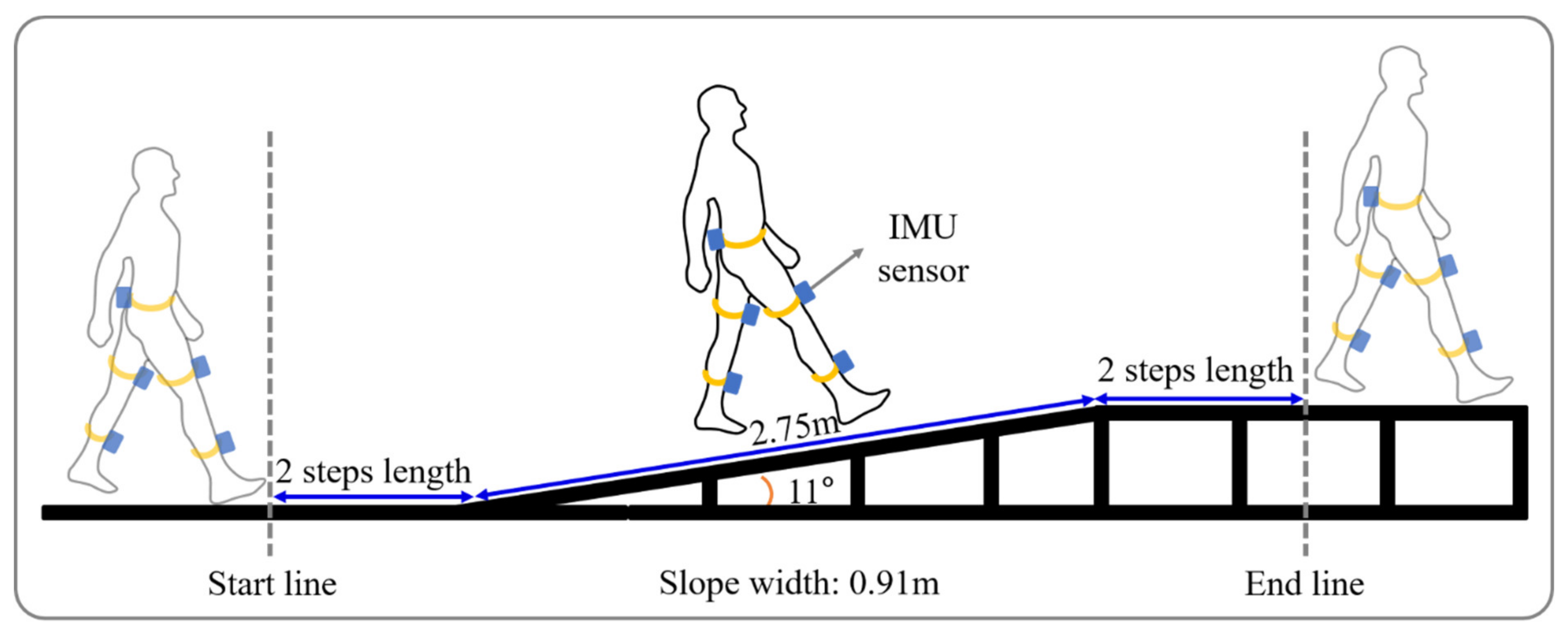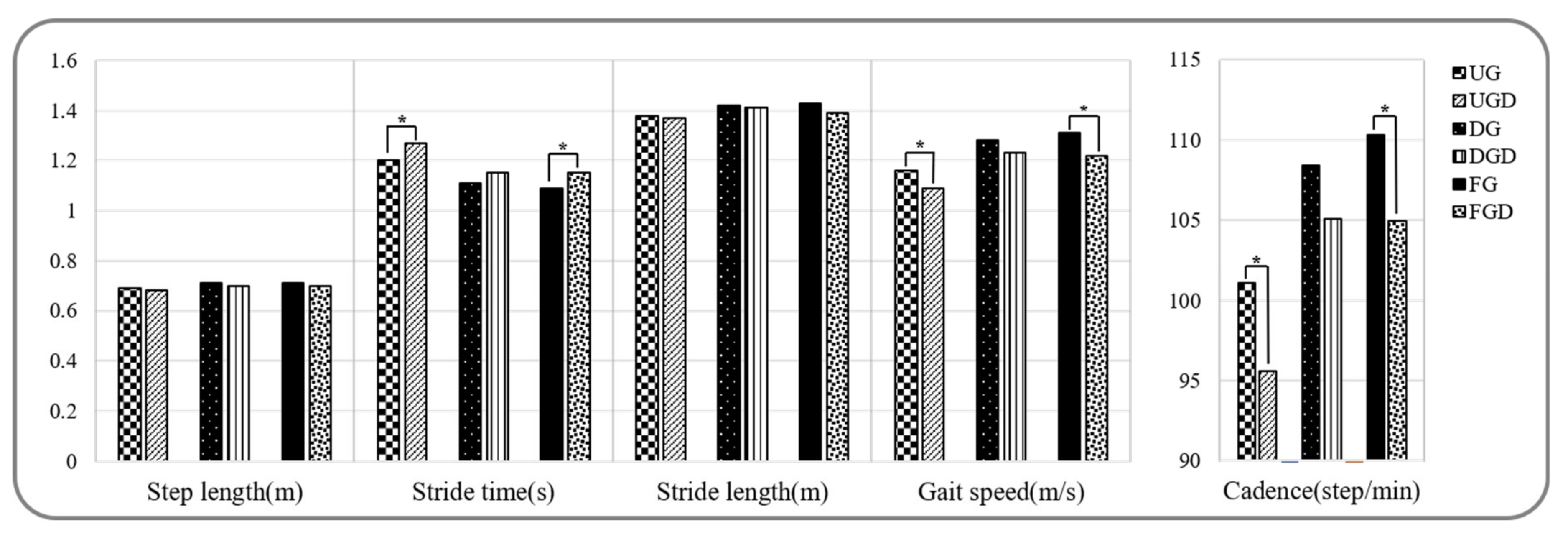Changes in Gait Parameters and Gait Variability in Young Adults during a Cognitive Task While Slope and Flat Walking
Abstract
:1. Introduction
2. Materials and Methods
2.1. Subjects
2.2. Apparatus
2.3. Protocol
2.4. The Cognitive Task
2.5. Data Analysis
3. Results
4. Discussion
5. Conclusions
Author Contributions
Funding
Conflicts of Interest
References
- Kusakunniran, W.; Wu, Q.; Li, H.; Zhang, J. Automatic gait recognition using weighted binary pattern on video. In Proceedings of the 6th AVSS, Genova, Italy, 29 August 2010; pp. 49–54. [Google Scholar]
- Vachranukunkiet, T.; Esquenazi, A. Pathophysiology of gait disturbance in neurologic disorders and clinical presentations. Phys. Med. Rehabil. Clin. N. Am. 2013, 24, 233–246. [Google Scholar] [CrossRef] [PubMed]
- Boyer, K.A.; Johnson, R.T.; Banks, J.J.; Jewell, C.; Hafer, J.F. Systematic review and meta-analysis of gait mechanics in young and older adults. Exp. Gerontol. 2017, 95, 63–70. [Google Scholar] [CrossRef] [PubMed]
- Takakusaki, K. Neurophysiology of gait: From the spinal cord to the frontal lobe. Mov. Disord. 2013, 28, 1483–1491. [Google Scholar] [CrossRef]
- Woollacott, M.; Shumway-Cook, A. Attention and the control of posture and gait: A review of an emerging area of research. Gait Posture 2002, 16, 1–14. [Google Scholar] [CrossRef]
- Hausdorff, J.M.; Schweiger, A.; Herman, T.; Yogev-Seligmann, G.; Giladi, N. Dual-task decrements in gait: Contributing factors among healthy older adults. J. Gerontol. 2008, 63, 1335–1343. [Google Scholar] [CrossRef] [PubMed]
- Amboni, M.; Barone, P.; Hausdorff, J.M. Cognitive contributions to gait and falls: Evidence and implications. Mov. Disord. 2013, 28, 1520–1533. [Google Scholar] [CrossRef] [PubMed]
- Shumway-Cook, A.; Woollacott, M. Attentional demands and postural control: The effect of sensory context. J. Gerontol. 2000, 55, M10. [Google Scholar]
- Al-Yahya, E.; Dawes, H.; Smith, L.; Dennis, A.; Howells, K.; Cockburn, J. Cognitive motor interference while walking: A systematic review and meta-analysis. Neurosci. Biobehav. Rev. 2011, 35, 715–728. [Google Scholar] [CrossRef]
- Perry, R.J.; Hodges, J.R. Attention and executive deficits in Alzheimer’s disease: A critical review. Brain 1999, 122, 383–404. [Google Scholar] [CrossRef] [Green Version]
- Soangra, R.; Lockhart, T.E. Dual-task does not increase slip and fall risk in healthy young and older adults during walking. Appl. Bionics Biomech. 2017. [Google Scholar] [CrossRef]
- Wickens, C.D. Attention and skilled performance. In Human Skills; Wiley: New York, NY, USA, 1989; pp. 71–105. [Google Scholar]
- Beauchet, O.; Dubost, V.; Herrmann, F.R.; Kressig, R.W. Stride-to-stride variability while backward counting among healthy young adults. J. Neuroeng. Rehabil. 2005, 2, 26. [Google Scholar] [CrossRef]
- Yeo, S.S. Changes of Gait Variability by the Attention Demanding Task in Elderly Adults. J. Korean Phys. Ther. 2017, 29, 303–306. [Google Scholar] [CrossRef] [Green Version]
- Ayoubi, F.; Launay, C.P.; Annweiler, C.; Beauchet, O. Fear of falling and gait variability in older adults: A systematic review and meta-analysis. JAMDA 2015, 16, 14–19. [Google Scholar] [CrossRef] [PubMed]
- Vieira, M.F.; Rodrigues, F.B.; Souza, G.S.D.S.; Magnani, R.M.; Lehnen, G.C.; Campos, N.G.; Andrade, A.O. Gait stability, variability and complexity on inclined surfaces. J. Biomech. 2017, 54, 73–79. [Google Scholar] [CrossRef] [PubMed]
- Springer, S.; Giladi, N.; Peretz, C.; Yogev, G.; Simon, E.S.; Hausdorff, J.M. Dual-tasking effects on gait variability: The role of aging, falls, and executive function. Mov. Disord. 2006, 21, 950–957. [Google Scholar] [CrossRef] [PubMed]
- Kerr, B.; Condon, S.; McDonald, L. Cognitive spatial processing and the regulation of posture. J. Exp. Psychol. Hum. Percept. Perform. 1985, 11, 617. [Google Scholar] [CrossRef] [PubMed]
- Rapport, M.D.; Kelly, K.L. Psychostimulant effects on learning and cognitive function: Findings and implications for children with attention deficit hyperactivity disorder. Clin. Psychol. Rev. 1991, 11, 61–92. [Google Scholar] [CrossRef]
- Falbo, S.; Condello, G.; Capranica, L.; Forte, R.; Pesce, C. Effects of physical-cognitive dual task training on executive function and gait performance in older adults: A randomized controlled trial. Biomed. Res. 2016, 12. [Google Scholar] [CrossRef]
- Gao, C.; Oksa, J.; Rintamäki, H.; Holmer, I. Gait muscle activity during walking on an inclined icy surface. Ind. Health 2008, 46, 15–22. [Google Scholar] [CrossRef] [Green Version]
- Sun, J.; Walters, M.; Svensson, N.; Lloyd, D. The influence of surface slope on human gait characteristics: A study of urban pedestrians walking on an inclined surface. Ergonomics 1996, 39, 677–692. [Google Scholar] [CrossRef]
- Cham, R.; Redfern, M.S. Changes in gait when anticipating slippery floors. Gait Posture 2002, 15, 159–171. [Google Scholar] [CrossRef] [Green Version]
- Pickle, N.T.; Grabowski, A.M.; Auyang, A.G.; Silverman, A.K. The functional roles of muscles during sloped walking. J. Biomech. 2016, 49, 3244–3251. [Google Scholar] [CrossRef] [PubMed] [Green Version]
- Al-Yahya, E.; Dawes, H.; Collett, J.; Howells, K.; Izadi, H.; Wade, D.T.; Cockburn, J. Gait adaptations to simultaneous cognitive and mechanical constraints. Exp. Brain Res. 2009, 199, 39–48. [Google Scholar] [CrossRef] [PubMed]
- Kuster, M.; Sakurai, S.; Wood, G.A. Kinematic and kinetic comparison of downhill and level walking. Clin. Biomech. 1995, 10, 79–84. [Google Scholar] [CrossRef]
- Redfern, M.S.; Dipasquale, J. Biomechanics of descending ramps. Gait Posture 1997, 6, 119–125. [Google Scholar] [CrossRef]
- Kawamura, K.; Tokuhiro, A.; Takechi, H. Gait analysis of slope walking: A study on step length, stride width, time factors and deviation in the center of pressure. Acta Med. Okayama 1991, 45, 179–184. [Google Scholar]
- Chamberlin, M.E.; Fulwider, B.D.; Sanders, S.L.; Medeiros, J.M. Does fear of falling influence spatial and temporal gait parameters in elderly persons beyond changes associated with normal aging? J. Gerontol. 2005, 60, 1163–1167. [Google Scholar] [CrossRef]
- Wright, M.; Roys, M. Accidents on English dwelling stairs are directly related to going size. Contemp. Ergon. 2008. [Google Scholar] [CrossRef]
- Chen, B.R. LEGSys: Wireless gait evaluation system using wearable sensors. In Proceedings of the 2nd Conference on Wireless Health, San Diego, CA, USA, 1–2 October 2011. [Google Scholar]
- Allali, G.; Kressig, R.W.; Assal, F.; Herrmann, F.R.; Dubost, V.; Beauchet, O. Changes in gait while backward counting in demented older adults with frontal lobe dysfunction. Gait Posture 2007, 26, 572–576. [Google Scholar] [CrossRef]
- Lin, M.-I.B.; Lin, K.-H. Walking while performing working memory tasks changes the prefrontal cortex hemodynamic activations and gait kinematics. Front. Behav. Neurosci. 2016, 10, 92. [Google Scholar] [CrossRef] [Green Version]
- Hollman, J.H.; Kovash, F.M.; Kubik, J.J.; Linbo, R.A. Age-related differences in spatiotemporal markers of gait stability during dual task walking. Gait Posture 2007, 26, 113–119. [Google Scholar] [CrossRef] [PubMed]
- Coppin, A.K.; Shumway-Cook, A.; Saczynski, J.S.; Patel, K.V.; Ble, A.; Ferrucci, L.; Guralnik, J.M. Association of executive function and performance of dual-task physical tests among older adults: Analyses from the InChianti study. Age Ageing 2006, 35, 619–624. [Google Scholar] [CrossRef] [PubMed] [Green Version]
- Lu, C.-F.; Liu, Y.-C.; Yang, Y.-R.; Wu, Y.-T.; Wang, R.-Y. Maintaining gait performance by cortical activation during dual-task interference: A functional near-infrared spectroscopy study. PLoS ONE 2015, 10, e0129390. [Google Scholar] [CrossRef] [PubMed] [Green Version]
- Bowen, A.; Wenman, R.; Mickelborough, J.; Foster, J.; Hill, E.; Tallis, R. Dual-task effects of talking while walking on velocity and balance following a stroke. Age Ageing 2001, 30, 319–323. [Google Scholar] [CrossRef] [PubMed] [Green Version]
- Hyndman, D.; Ashburn, A.; Yardley, L.; Stack, E. Interference between balance, gait and cognitive task performance among people with stroke living in the community. Disabil. Rehabil. 2006, 28, 849–856. [Google Scholar] [CrossRef]
- Plummer-D’Amato, P.; Altmann, L.J.; Saracino, D.; Fox, E.; Behrman, A.L.; Marsiske, M. Interactions between cognitive tasks and gait after stroke: A dual task study. Gait Posture 2008, 27, 683–688. [Google Scholar] [CrossRef] [Green Version]
- Kemper, S.; McDowd, J.; Pohl, P.; Herman, R.; Jackson, S. Revealing language deficits following stroke: The cost of doing two things at once. Neuropsychol. Dev. Cogn. B Aging Neuropsychol. Cogn. 2006, 13, 115–139. [Google Scholar] [CrossRef]
- Ferraro, R.A.; Pinto-Zipp, G.; Simpkins, S.; Clark, M. Effects of an inclined walking surface and balance abilities on spatiotemporal gait parameters of older adults. J. Geriatr. Phys. Ther. 2013, 36, 31–38. [Google Scholar] [CrossRef]
- Saunders, J.B.; Inman, V.T.; Eberhart, H.D. The major determinants in normal and pathological gait. The Journal of bone and joint surgery. JBJS 1953, 35, 3, 543–558. [Google Scholar] [CrossRef]
- Leroux, A.; Fung, J.; Barbeau, H. Postural adaptation to walking on inclined surfaces: I. Normal strategies. Gait Posture 2002, 15, 64–74. [Google Scholar] [CrossRef]
- Lange, G.W.; Hintermeister, R.A.; Schlegel, T.; Dillman, C.J.; Steadman, J.R. Electromyographic and kinematic analysis of graded treadmill walking and the implications for knee rehabilitation. J. Orthop. Sports Phys. Ther. 1996, 23, 294–301. [Google Scholar] [CrossRef] [PubMed] [Green Version]
- McIntosh, A.S.; Beatty, K.T.; Dwan, L.N.; Vickers, D.R. Gait dynamics on an inclined walkway. J. Biomech. 2006, 39, 2491–2502. [Google Scholar] [CrossRef] [PubMed]
- Sekiya, N.; Nagasaki, H.; Ito, H.; Furuna, T. Optimal walking in terms of variability in step length. J. Orthop. Sports Phys. Ther. 1997, 26, 266–272. [Google Scholar] [CrossRef]
- Maki, B.E. Gait changes in older adults: Predictors of falls or indicators of fear. J. Am. Geriatr. Soc. 1997, 45, 313–320. [Google Scholar] [CrossRef] [PubMed]
- Toebes, M.J.; Hoozemans, M.J.; Furrer, R.; Dekker, J.; van Dieen, J.H. Local dynamic stability and variability of gait are associated with fall history in elderly subjects. Gait Posture 2012, 36, 527–531. [Google Scholar] [CrossRef] [PubMed] [Green Version]



| Gender | Number of Subjects | Age | Height (cm) | Weight (kg) |
|---|---|---|---|---|
| Male | 10 | 25.00 (1.94) | 170.70 (7.18) | 71.10 (11.99) |
| Female | 20 | 22.15 (1.39) | 162.10 (4.85) | 52.80 (4.82) |
| Total | 30 | 23.10 (2.07) | 164.97 (6.96) | 58.90 (11.70) |
© 2020 by the authors. Licensee MDPI, Basel, Switzerland. This article is an open access article distributed under the terms and conditions of the Creative Commons Attribution (CC BY) license (http://creativecommons.org/licenses/by/4.0/).
Share and Cite
Park, G.Y.; Yeo, S.S.; Kwon, Y.C.; Song, H.S.; Lim, Y.J.; Ha, Y.M.; Han, S.H.; Oh, S. Changes in Gait Parameters and Gait Variability in Young Adults during a Cognitive Task While Slope and Flat Walking. Healthcare 2020, 8, 30. https://doi.org/10.3390/healthcare8010030
Park GY, Yeo SS, Kwon YC, Song HS, Lim YJ, Ha YM, Han SH, Oh S. Changes in Gait Parameters and Gait Variability in Young Adults during a Cognitive Task While Slope and Flat Walking. Healthcare. 2020; 8(1):30. https://doi.org/10.3390/healthcare8010030
Chicago/Turabian StylePark, Ga Young, Sang Seok Yeo, Young Chan Kwon, Hyeong Seok Song, Yu Jin Lim, Yu Mi Ha, Seung Hee Han, and Seunghue Oh. 2020. "Changes in Gait Parameters and Gait Variability in Young Adults during a Cognitive Task While Slope and Flat Walking" Healthcare 8, no. 1: 30. https://doi.org/10.3390/healthcare8010030





